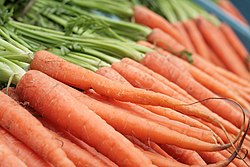Vitamins are grouped into two categories:
- Fat-soluble vitamins are stored in the body's fatty tissue. The four fat-soluble vitamins are vitamins A, D, E, and K. These vitamins are absorbed more easily by the body in the presence of dietary fat.
- There are nine water-soluble vitamins. The body must use water-soluble vitamins right away. Any leftover water-soluble vitamins leave the body through the urine. Vitamin B12 is the only water-soluble vitamin that can be stored in the liver for many years.

FAT-SOLUBLE VITAMINS
Vitamin A:
- Dark-colored fruit
- Dark leafy vegetables
- Egg yolk
- Fortified milk and dairy products (cheese, yogurt, butter, and cream)
- Liver, beef, and fish
Vitamin D:
- Fish (fatty fish such as salmon, mackerel, herring, and orange roughy)
- Fish liver oils (cod's liver oil)
- Fortified cereals
- Fortified milk and dairy products (cheese, yogurt, butter, and cream)
Vitamin E:
- Avocado
- Dark green vegetables (spinach, broccoli, asparagus, and turnip greens)
- Margarine (made from safflower, corn, and sunflower oil)
- Oils (safflower, corn, and sunflower)
- Papaya and mango
- Seeds and nuts
- Wheat germ and wheat germ oil
Vitamin K:
- Cabbage
- Cauliflower
- Cereals
- Dark green vegetables (broccoli, Brussels sprouts, and asparagus)
- Dark leafy vegetables (spinach, kale, collards, and turnip greens)
- Fish, liver, beef, and eggs
WATER-SOLUBLE VITAMINS
Biotin:
- Chocolate
- Cereal
- Egg yolk
- Legumes
- Milk
- Nuts
- Organ meats (liver, kidney)
- Pork
- Yeast
Folate:
- Asparagus and broccoli
- Beets
- Brewer's yeast
- Dried beans (cooked pinto, navy, kidney, and lima)
- Fortified cereals
- Green, leafy vegetables (spinach and romaine lettuce)
- Lentils
- Oranges and orange juice
- Peanut butter
- Wheat germ
Niacin (vitamin B3):
- Avocado
- Eggs
- Enriched breads and fortified cereals
- Fish (tuna and salt-water fish)
- Lean meats
- Legumes
- Nuts
- Potato
- Poultry
Pantothenic acid:
- Avocado
- Broccoli, kale, and other vegetables in the cabbage family
- Eggs
- Legumes and lentils
- Milk
- Mushroom
- Organ meats
- Poultry
- White and sweet potatoes
- Whole-grain cereals
Thiamine (vitamin B1):
- Dried milk
- Egg
- Enriched bread and flour
- Lean meats
- Legumes (dried beans)
- Nuts and seeds
- Organ meats
- Peas
- Whole grains
Pyroxidine (vitamin B6):
- Avocado
- Banana
- Legumes (dried beans)
- Meat
- Nuts
- Poultry
- Whole grains (milling and processing removes a lot of this vitamin)
Vitamin B12:
- Meat
- Eggs
- Fortified foods such as soymilk
- Milk and milk products
- Organ meats (liver and kidney)
- Poultry
- Shellfish
NOTE: Animal sources of vitamin B12 are absorbed much better by the body than plant sources
Vitamin C (ascorbic acid):
- Broccoli
- Brussels sprouts
- Cabbage
- Cauliflower
- Citrus fruits
- Potatoes
- Spinach
- Strawberries
- Tomato juice
- Tomatoes










0 Comments:
Post a Comment